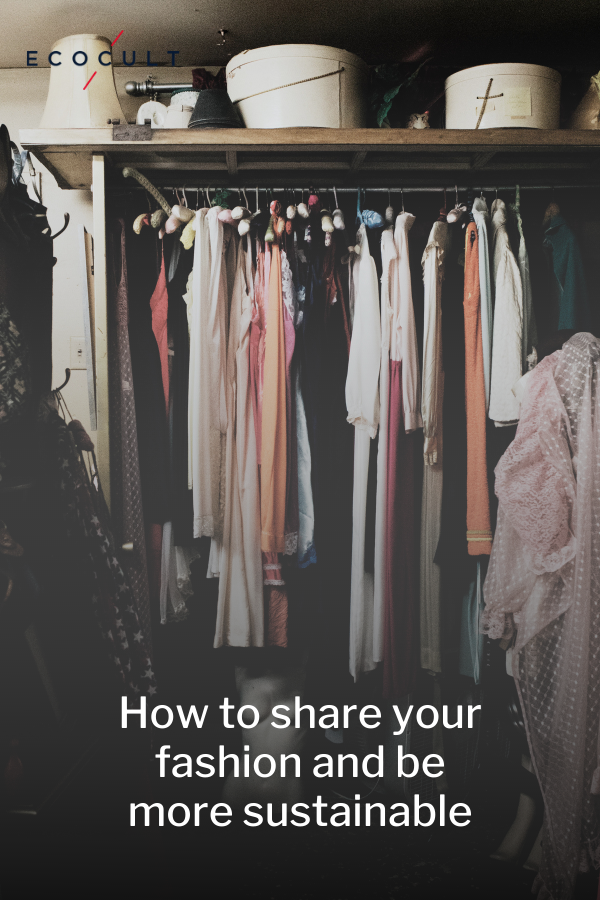Disclosure: As an Amazon Associate I earn from qualifying purchases. This page may contain affiliate links, which means I may receive a commission if you click a link and purchase something that I have recommended. There is no additional cost to you whatsoever.
Imagine a fashion system where every garment was made to last and designed to be resold, rented or swapped. Imagine buying clothing with the intention of wearing and sharing, rather than hoarding. Imagine your wardrobe constantly rotating with “new” clothes, repeatedly reinventing your style without ever clicking “add to cart”.
What you’re imagining is the sharing economy, a growing sustainable fashion movement that turns the entire retail model on its head. From WhatsApp chats with friends to COVID-safe swap shop events, people are increasingly participating in a new kind of marketplace based on an old way of trading, where the product itself is the currency. As traditional retail models crumble and sharing economy startups thrive, the future of consumption is peer-to-peer.
What Is the Sharing Economy?
In modern, market-based economies, most goods and services are exchanged via a system of production, consumption and waste. By 2030, global clothing and shoes consumption is expected to reach 102 million tons (roughly equivalent to more than 660 billion T-shirts), and in the US over 9 million tons of clothing and footwear were sent to the landfill in 2018.
As an alternative, the sharing economy re-introduces the ancient idea of redistributing products and services amongst the community, instead of relying on individual ownership.
If you look up the sharing economy online, you’ll encounter well-known corporate examples like Airbnb, where housing is shared, and Uber, where cars are shared. You might also see this system described as ‘collaborative consumption’, in which groups and individuals exchange and share products on a peer-to-peer basis.
In the fashion industry, the sharing economy can refer to activities like swapping, renting and resale, which are all methods of accessing products that already exist instead of purchasing new ones. At its core, fashion’s sharing economy is all about fulfilling the original purpose of clothes, and that is simply to be worn. When shared instead of simply sold and bought, a garment can be worn over and over, multiplying the different lives it can live.
If you’re wondering about the difference between the sharing economy and the circular economy, both models aim to help reduce the need for new production, but sharing is all about keeping the garments themselves in circulation instead of relying on recycling to lighten the load. But is sharing more sustainable than shopping? According to WRAP, extending the life of half of the garments in the UK by just nine months could reduce its carbon, water and waste footprint by 22%.
However, the exact numbers on the sustainability of sharing clothing are difficult to quantify, because there are very few studies that conduct a full life cycle analysis on a garment throughout all its different rounds of wearing and sharing. There can also be the risk of a rebound effect, where people who take part in clothes sharing also increase their consumption in other ways. Therefore, if you want to build a sustainable wardrobe, it’s important to take into account the entire spectrum of your shopping habits.
Beyond the environmental side, sharing offers plenty of other benefits. Offloading old clothes from your overcrowded closet can be a huge plus, not to mention the more affordable prices of secondhand fashion, opportunities to experiment with your style, and even the potential to make friends through clothes-sharing communities.
How to Share Clothing Online
Usually, we would wholeheartedly recommend attending or organizing an in-person clothes swap, but during the pandemic, sharing has gone digital.
For safe swapping, try websites and apps like Nuw and The Dress Change, which operate on a credit system, so you can upload as many items as you like and use the rewards to “spend” on more items. Swopped offers subscriptions with a limited number of like-for-like items for $9 per month, while Swap Society sets a minimum price of $3.99 for each item. Big Sister Swap sends you a personalized bundle of “new” clothes in exchange for your old ones, and Reshash lets you request to swap specific items that you’re looking for.
Another option is to go old school and head to Freecycle, a grassroots non-profit site where members all around the world can get their hands on items for absolutely zero cost. On Facebook, thousands of local community groups offer mutual aid through bartering a variety of items, including clothing — maybe you need to offload some old tote bags, but next week, someone offers you a free desk chair or hires out their lawnmower. Keep in mind that you get out what you put in, so all of these platforms are a brilliant way to follow the one-in-one-out rule and minimize waste in your wardrobe.
When you’re looking to make a little extra income through sharing, fashion resale sites like Vinted and ThredUp are tried and trusted. For luxury items, Vestiaire Collective is a go-to destination for buying and selling preloved designer labels, and there are dozens more brilliant online second-hand shopping platforms to explore. Another option is secondhand fashion app Depop, where many users bypass the service fees by offering direct swaps for their preloved garments, rather than just buying and selling.
If you fancy trying out rental fashion, where you borrow a garment for a short time before passing it onto someone new, ByRotation is a great option for one-off items, while Gwynnie Bee offers an unlimited subscription for clothing up to size US 32. Men can try The Devout for a monthly capsule wardrobe of five different items, and new startup Seasons is a members-only app for designer menswear rental, with free dry cleaning included. For luxury occasionwear, Rent the Runway has the largest fashion rental selection on the market, and regularly collaborates with department stores like Nordstrom. Wardrobe lets you rent luxury fashion straight from other women’s closets, as well as rent out your own luxury pieces that you’re not wearing.
Onloan’s new resale platform Offloan showcases a range of designer products that have previously been rented, now available to buy at up to 80% off the retail price to keep them out of the landfill. This system, co-founder Natalie Hasseck says, allows customers to test-drive a product before giving it a “forever home”, and any small imperfections in the preloved garments simply add to their charm. Renting before buying also encourages them to be more experimental and creative with their style during the pandemic, in a phenomenon that Natalie describes as “a shift from status dressing to pleasure dressing.”
Brands Who Support the Sharing Model
“Brands would be silly not to play a part in the sharing economy,” says Hasseck. To do so and do so well, designers need to consider the afterlife of their garments right from the very beginning, investing in timeless styles and quality materials. “Brands should be extending their own value by designing products with the intention of rental and resale,” she adds. “They should already be thinking about their legacy, and stop thinking about trends.”
Along with making quality clothing, we need brands to take responsibility for their products long after they arrive in their customer’s wardrobes. This is where “product-service systems” come in, where brands provide add-ons like repair services, take-back schemes and rental options.
In 2019, URBN group launched Nuuly to allow customers to borrow clothing from Urban Outfitters, Anthropologie and Free People. Their subscription-based model is designed to appeal to those who still regularly crave fresh styles, offering six “new” items every month for $88.
Urban Outfitters is problematic, however. If you’re looking to move away from fast fashion, circular brands like Mud Jeans offer the option to lease your jeans on a monthly basis, or purchase a pair and later trade them in to be recycled. Other retailers include Selfridges, which offers a leasing service in collaboration with rental platform HURR.
Levi’s Secondhand offers customers a chance to trade-in their old products in exchange for store gift cards, and then the used denim is resold on the site at a significant discount. Sustainable womenswear brands Eileen Fisher and Filippa K have long been champions of the sharing economy too, both providing sister sites that sell used and reworked garments from past-season collections.
Sustainable outerwear brand Patagonia has found success through refurbishment and resale with Worn Wear, a program designed to provide a range of services to extend the life of Patagonia products. It even offers upcycled items made from reclaimed waste called the ReCrafted collection, proving that even when garments are past the point of repair, they can be reworked into something new, and shared once again. Outdoor brands like Arc’Teryx and The North Face also run their own repair and take-back schemes to make your gear last longer.
In Conclusion…
Whether you take style risks with rental and resale, take pleasure in being part of a swapping community, or are looking to save money on fashion, there are countless ways to benefit from the shared wardrobe. When you share your clothes, you’re rejecting the mainstream fashion system of take-make-waste and investing in a new kind of economy where access matters more than ownership, and your personal style is more important than the size of your closet.
![]()
![]()







